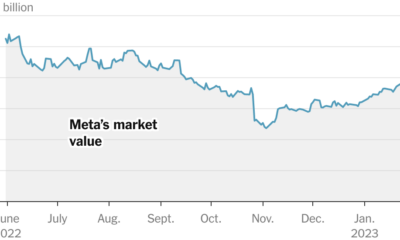MARKETING
How It’s Changed and Where It’s Going in the Next Decade

A sound content marketing strategy is one of the better ways a business can help shape its brand identity, garner interest from prospects, and retain an engaged audience. It lets you establish authority in your space, project legitimacy, and build trust between you and who you’re trying to reach.
As you can assume, it’s well worth understanding. But that’s easier said than done. Content marketing isn’t static. The landscape of the practice is constantly changing. It doesn’t look the same now as it did ten years ago, and in ten years it won’t look the same as it does now.
It’s a difficult topic to pin down — one with a fascinating past and an exciting future. Out of both genuine interest and forward-thinking practicality, it’s important to understand both where it’s been and where it’s going.
Here, we’ll get some perspective on both. We’re going to take a look at how content marketing has evolved in the past decade, and how it’s going to evolve in the next one according to expert predictions.
How Content Marketing Evolved in the Past Decade
Google changed the game.
In 2011, Google conducted its landmark Zero Moment of Truth (ZMOT) study. It found that 88% of shoppers use what’s known as a Zero Moment of Truth — a discovery and awareness stage in a buying cycle where a consumer researches a product before buying it. Google’s research also indicated that word of mouth was a definitive factor in swaying that moment.
The study provides a unique point of reference in the context of content marketing’s evolution. It captures the essence of how and why businesses needed to focus on content marketing at the beginning of the 2010s.
It was tacit evidence that companies’ stories were being told online — well beyond the control of their marketing departments — and it was in their best interest to help shape those conversations.
The ZMOT study highlighted the need for sound Search Engine Optimization (SEO). Ranking for relevant keywords on search engines became all but essential to bolstering a company’s online presence and holding up during consumers’ Zero Moments of Truth.
But that study wasn’t the only bombshell Google dropped in the early 2010s. Around the time the study came out, Google’s search ranking algorithm changed to discourage “keyword stuffing” — the practice of repetitively loading a webpage with specific keywords to try to sway search engine rankings.
The change represented what is still a continuous effort by Google to provide users with positive, helpful online experiences. And it did just that. The shift that set the stage for businesses to focus on producing more high-quality, meaningful content.
Social media rose.
But content marketing’s evolution wasn’t exclusively linked to search engines. Social media’s meteoric rise to prominence — one of the most disruptive trends in human history — also had a profound impact on the practice. As these platforms developed into mainstays of everyday life, they presented new challenges for content marketers.
As social media evolved, it popularized a different kind of content consumption than search engines. The difference boiled down to a matter of “pointed versus passive.”
Consumers use search engines to find content more pointedly. Generally speaking, when you use a search engine, you’re looking for a specific answer or a specific subject. Social media allowed users to consume content more passively on their preferred platforms. The content you see on your Facebook feed is finding its way to you — not the other way around.
That trend incentivized the creation of more shareable, attention-grabbing content that could easily be spread across social media channels.
In fact, as of 2021, social media is now the primary channel used by marketers, with over 80% of marketers using social media — by comparison, only roughly 40% use content marketing and SEO.
Video made a push.
Video also emerged as one of the prevailing content marketing mediums as the decade progressed, particularly among younger consumers.
As of 2021, roughly 70% of marketers say video is now their primary form of media used in their content strategies.
Additionally, nearly nine out of ten people report wanting to see more videos from brands.
Video is inherently engaging. Generally speaking, it’s easier to follow than blog posts, email newsletters, or ebooks. Gradually, audiences took to it more and more as the decade progressed. By the end of the 2010s, platforms like YouTube were central to the landscape of content marketing.

Obviously, content marketing underwent several shifts in the 2010s, but as I said at the beginning of this article, the practice isn’t — and will never be — static. There are still plenty of changes to come.
How Content Marketing Will Evolve in the Next Decade

Video content will continue to rule.
As I just mentioned, video was emerging as one of the most — if not the most — important mediums for content marketing at the end of this past decade. There’s no indication that that trend is stopping anytime soon.
In 2020, media uploads increased 80% year-over-year, demonstrating how the pandemic accelerated the popularity of video creation and consumption.
And, as Canva’s B2B Head of Content Rachael Perry points out,
“Video content is positioned for massive growth now, especially as video-first social platforms like TikTok continue to rule.”
Perry says, “Almost everyone creates and absorbs visual content in today’s world, and video is a great way to bring your brand to life and build more personal connections with your audience.”
Perry adds, “Until now, video creation has been complex, but there are new tools making it easier. If you can understand what your audience truly needs, video can help you provide that value in a memorable way.”
All told, it looks like the exploration and expansion of video as the preeminent medium for content marketing is going to continue. The priority for marketers is going to be a matter of standing out.
That could mean emphasizing the quality of the content you produce — ensuring it’s enriching, well-crafted, and relevant to viewers. You could also try looking to emerging platforms like TikTok.
CEO & Co-Founder of Slidebean, Jose (Caya) Cayasso, told me he encourages brands to step outside the more traditional avenues of content marketing — blogging, email marketing, and SEO — to create “wider moats” around their content efforts.
He says, “[At Slidebean] we decided to bet on YouTube, and it’s become our most significant source of revenue and brand awareness. Alternatively, companies like Morning Brew and Duolingo are killing it on TikTok — but requires us to reinvent ourselves constantly, and to break the status quo of typical corporate content.”
Cayasso adds, “You have to be incredibly clever and adaptable to succeed in video content — even more so if you’re a brand, versus an individual.”
No matter how individual producers and companies manage to innovate when it comes to video marketing, the medium is going to be a mainstay in the evolution of content marketing going forward.
Adjusting for mobile will be essential and present new opportunities.
According to Statista, global mobile data traffic in 2022 will be seven times larger than it was in 2017. Mobile device usage is increasing astronomically, and it’s in every content marketer’s best interest to keep pace with that trend.
In 2021, 61% of Google searches took place on a mobile device, and that trend is showing no signs of slowing down. Having a website optimized for mobile devices will be central to successful SEO efforts. And a lot of the content you create will need to fit that bill as well.
Blogs should be easily navigable on smartphones. Readily accessible video content that your audience can watch on mobile devices will be a big help as well. Prospects and customers will need to be able to get as much out of your mobile resources as your desktop ones.
This shift towards mobile will also present new opportunities through emerging kinds of media. More novel mobile technology — like virtual and augmented reality — will have a very real place in the future of content marketing.
As people continue to rely more on their mobile devices, content marketers will have to as well.
Successful content will be more empathetic, purposeful, and customer-first.
Google’s ranking algorithm aims to prioritize the content that will mean the most to searchers. Ideally, by Google’s standards, the first ranking search result for any keyword is the one that best addresses whatever users are searching for. And in all likelihood, they’ll keep tinkering with their process in pursuit of that interest.
While there’s no telling exactly how the algorithm might change going forward, one fact remains — marketers need to focus on high-quality content that will register with consumers. That means understanding your audience and putting considerable effort into how to reach them best.
As HubSpot Senior Content Strategist Amanda Zantal-Wiener puts it, “Where I’m starting to see content turning a corner is in the area of empathy. In the years to come, marketers are going to start creating more content that’s truly created in the mindset of putting themselves in the shoes of others — be it their customers, prospects, partners, or someone else within their audiences.”
She adds, “They’ll ask questions like, ‘What does my audience need from me right now? What can I create that’s truly going to help them?’ That’s going to become a requirement for marketers when they begin brainstorming content.”
Content marketing is trending towards audience enrichment as opposed to product promotion. If this shifting tide holds true, content marketing will continue to become more targeted, purposeful, and customer-centric as the practice evolves.
As Katelyn Seese, Content Strategist at Blue Frog, puts it, “Content marketing has the power to make real connections with your audience and educate them of the value of your brand beyond your services, products, or offerings. Consumers care much more today about the who and why of your brand rather than just what you do. Understanding who your audience is and why they need your brand is the key to creating meaningful content that truly resonates with your audience.”
Of course, content creation isn’t easy. Fortunately, Kim Giroux, Director of Marketing at Beautiful.ai, believes the future includes an increase in tools that should help your writers with content creation and design.
Giroux told me, “Over the next decade, content creation will be automated with tools backed by artificial intelligence and natural language processing. Widespread adoption of such tools will give marketers the ability to create quality content in a fraction of the time. At the same time, integrations will simplify tech stacks and end-user experiences. Professionals will no longer need to understand complex tools, while workflows and team collaboration will be seamless.”
She adds, “With automation in content creation tools as the norm, designing or branding content such as presentations, infographics, blog posts and white-papers will be effortless.”
“The days of spending hours formatting and incorporating brand elements and design principles into every piece of content will be long gone. Smart technology will instantly create branded, visually appealing collateral, freeing up marketers’ brainpower to focus solely on the messaging and strategy behind a brand.”
Historical optimization will become increasingly important.
Basha Coleman, a Historical Optimization Marketing Manager at HubSpot, believes the future of content marketing will include an increased awareness and dedication to historical optimization.
She says, “As we enter an era where competitive content is appearing each minute, content teams will find it worthwhile to extract more value out of every minute spent on content development.”
Coleman adds, “That means existing material that is updated with new data and trends can compete with brand new content on the same topic, while spending less time and resources to produce it.”
If you don’t already, consider investing in a strong optimization strategy for 2022 and beyond. This will help you create consistently relevant and high-ranking content without constantly starting from scratch, and is a critical SEO tactic for maintaining authority in the SERPs.

Marketers will use more interactive content on their websites.
Nowadays, consumers are interested in easily-digestible, interactive content. In fact, 45% of B2B buyers say interactive content is one of their top three preferred content types, and interactive content gets 2X more engagement than static content.
To serve your audience’s needs, consider how you might implement more interactive content, which breaks up long paragraphs of text and provides the viewer with an alternative method for consuming content.
As VP of Marketing at Trusted Health Jill Callan puts it, “With average attention spans dwindling down to less than that of a goldfish, brands can no longer afford to have one-way conversations with their audience.”
Callan says, “Interactive content on your website or blog can help engage visitors and make complex information easy to digest.”
Callan adds, “At my company, Trusted Health, we’ve used this approach to engage our nursing audience with things like our Salary Calculator, which helps nurses get detailed salary and cost of living information for every state. The best part? Creating contextual user experiences needn’t suck up precious product or engineering resources.”
If you aren’t sure how to begin, you’re in luck. Callan shared with me three tips to kick-start your interactive content journey:
- Embed an ROI calculator on your website to show potential customers how you will save them money. An interactive tool immediately shows your product’s value versus relying on text-heavy copy to explain it.
- Crowd-source product innovation. Tap into your brand advocates and loyal customers to learn more about their pain points and product wishlist. Use those insights to inform a product roadmap.
- Create a quiz. Not only are quizzes a great way to engage visitors, they also give you a better understanding of your audience so you can create more targeted campaigns in the future.
Zero-party data will become the preferred option for collecting prospect and customer data.
The way we use cookies and other ad-tracking tools in the next decade will change dramatically.
Marketers will need to continue prioritizing the security of their prospects and customers’ data, or risk losing their consumers’ trust.
To do this, many marketers will switch from using first, second, or third-party data to using zero-party data, which is data collected voluntarily from customers in exchange for value. Zero-party data goes beyond email address or phone number, and instead can include personal context, interests, and preferences — in return, prospects and customers can expect a more personalized consumer experience.
As Senior Director of Marketing at Microsoft Advertising John Cosley told me, “Zero-party data is the foundation for a relationship built on trust and a value exchange. For consumers, it holds the promise of a personalized and more relevant experience with brands. In return, brands and businesses receive better insight and a longer-term relationship.”
 Using zero-party data enables you to create trust between your brand and its consumers, while also ensuring you’re delivering the most personalized content possible for your customers. As other types of data collection are phased out — including third-party cookies — you’ll see marketers shift to zero-party data in the next decade.
Using zero-party data enables you to create trust between your brand and its consumers, while also ensuring you’re delivering the most personalized content possible for your customers. As other types of data collection are phased out — including third-party cookies — you’ll see marketers shift to zero-party data in the next decade.
If there’s anything to take away from understanding the previous and upcoming evolutions of content marketing it’s this — don’t get too comfortable. New trends and challenges are always emerging, and it will always be in your best interest to stay abreast of them.
And above all else, focus on consistently creating high-quality content that your audience will always be able to get something out of.
Editor’s note: This post was originally published in May 2020 and has been updated for comprehensiveness.
Source link














![Meta Publishes Report into How the Pandemic has Changed the Way That People Connect [Infographic] Meta Publishes New Report into How the Pandemic has Changed the Way That People Connect [Infographic]](https://articles.entireweb.com/wp-content/uploads/2022/06/1654824633_Meta-Publishes-New-Report-into-How-the-Pandemic-has-Changed.png)
You must be logged in to post a comment Login